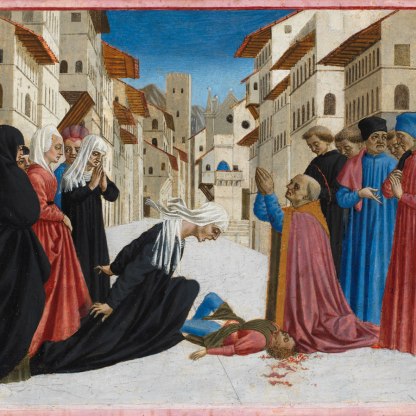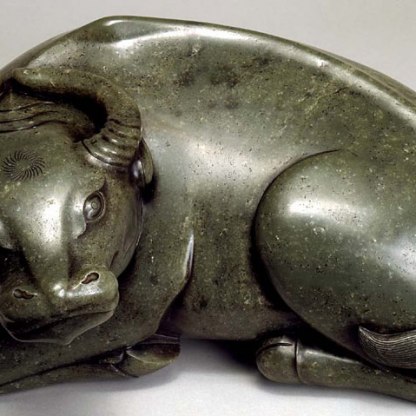False door of Hemi-Ra

This limestone slab covered with hieroglyphic inscriptions, known as a stela, takes the form of a false door. Objects of this kind were carved into the walls of tombs or on to stelae placed inside tomb chapels to allow the ka-spirit of the person named to pass through the door from the netherworld into this world in order to receive offerings.
The hieroglyphs, carved in sunk relief, identify the person as a woman called Hemi-Ra, a priestess of Hathor Mistress of Djedu (the town of Busiris in Lower Egypt). She is depicted in several different places on the false door. In the topmost scene in the centre, Hemi-Ra is shown sitting on a chair, with a table of offerings in front of her. Below that is another image of Hemi-Ra smelling a waterlily (often referred to as a lotus flower). At the bottom of the stela, she is shown several times in different ways. At the right and left, she appears twice, in a standing pose with one foot advanced, wearing a calf-length robe and holding a waterlily to her nose. Her breasts are distinctly carved in a drooping fashion. In the centre, there are also two representations of her as a younger person (indicated by the distinctive hairstyle), sitting on a stool, again smelling a waterlily flower.
The stela has been the subject of some scholarly attention in the past, particularly by Professor Henry Fisher in 1976, who suggested that the figures of Hemi-Ra show her at three different phases of her life: as a young girl and as an older woman at the bottom of the stela, and in the prime of her life at the top. He also suggested that the stela was originally set up in Busiris, a site that has not been explored in great detail, despite being an important cult site for Osiris, the most important funerary god in ancient Egypt.
More recent study at the Fitzwilliam, working with a geologist and a stonemason, has indicated that the stela has been modified, probably at least twice. The pose of the standing figures at the bottom is more normally associated with male figures and women more usually wear full-length robes. In addition, the hands of these figures are clenched around folded pieces of cloth, again a very male attribute. This is suggestive that the stela was originally carved for a man. The topmost figure of Hemi-Ra, sitting in front of offerings, also appears to have been modified, as there are several changes to the depiction of her head and several marks in front of her leg which suggest a change there. The surface of the stone in this area is also markedly smoother than elsewhere.
The patina of the stone at the top of the stela is relatively uniform, while the figures at the bottom of the stela are much whiter, most noticeably in the areas of the faces and breasts of the standing figures. The area featuring the offering scene at the top of the stela also appears to be setback quite deeply with a downward sloping profile, suggesting it was re-carved when the door was standing upright, possibly even in the tomb.
There are extensive traces of red paint over the surface of the stela, suggesting that the original limestone was painted to look like a more expensive stone, such as granite. This was a relatively common practice in ancient Egypt. Careful examination of these paint traces, however, indicates that perhaps by the time these modifications were made the red pigment on the door had already faded.
Research into the stela's hieroglyphic inscriptions and architectural and stylistic properties also suggests a different provenance for the door, most probably the Memphite nome (near the modern day capital of Cairo). As already suggested, there is also very little in the way of concrete binding evidence linking the door to Busiris.
Study of this stela continues as we try to unravel the reason behind these changes to the stela. Our current hypothesis is that the stela was originally made for a man, but that it was modified to be used by Hemi-Ra before it left the craftsmen’s workshop where it was carved. It was also painted red at that point. The later changes were probably made much more recently, when the stela was in the antiquities trade in Egypt. Its acquisition history indicates that it came to the Museum in 1909 via a dealer in Cairo who was known to modify objects, or even to create fakes. It is clear that the stela is genuine, but this could be an example of an object to which changes have been made to make it more “attractive” to potential buyers.
Core research team: Melanie Pitkin and Helen Strudwick (Egyptologists) Trevor F. Emmett (Geologist) Matthew Beesley (Stonemason/Lettercutter) Julie Dawson and Flavia Ravioli (Conservators)
Themes and periods
Data from our collections database
Limestone stela in the form of a false door belonging to a woman named Hemi-Ra. The door comprises two pairs of door jambs inscribed with vertical columns of hieroglyphic text, a lintel, or crossbar, with horizontal rows of hieroglyphic text and a rectangular panel with apertures at the top which is broken, but would have once been T-shaped. There is also a narrow, central niche in the middle of the door and a drum at the top (just below the lintel). The top part of the door is missing, but would have originally comprised a cavetto cornice with torus moulding and upper lintel. Hemi-Ra is shown multiple times on the door and past scholarly literature, particularly by Henry Fischer (1976), has suggested that the figures represent the female owner at three different phases of her life: as a young girl (the seated figures at the bottom of the inner jambs), a woman 'in her prime' (on the lintel and central panel) and as an older woman with frontal, drooping breasts (on the outer jambs). However, interdisciplinary research undertaken by the Fitzwilliam Museum between 2019 and 2021 indicates that the stela has been modified, probably at least twice. This is evident through changes in patina in the stone, tool marks and deeper carving in two key areas of the door - the central panel, and all of the upper bodies and the whole proper right outer figure of the figures depicted at the bottom of the jambs. These areas are also devoid of any red pigment, while red pigment can be detected elsewhere on the door - suggesting the door was once completely painted red to imitate the more expensive stone granite, and that the re-carving took place at some point after the pigment had faded. The pose and attire of the figures at the bottom of the door, which are more normally associated with male figures, is also suggestive that the door was originally carved for a man. In terms of the door's provenance, Fischer attributes the door to Busiris in the Nile Delta based on the epithet 'one revered of Hathor, the lady of Busiris'. However, examination of this title in association with the other inscriptions, and the door's architectural and stylistic properties, would point to a provenance of the Memphite nome instead. Publication of this stela is currently underway. For more information, see also: https://beta.fitz.ms/objects-and-artworks/highlights/E16909
Legal notes
Bought by Frederick William Green from Michel Casira, 1909
Acquisition and important dates
- Method of acquisition: Bought
- Dates: 1909
Dating
Place(s) associated
- Memphite
Materials used in production
Read more about this record3D scan
Accessibility Notice:
The 3D model on this page is hosted on Sketchfab and may not be fully accessible to everyone, including users of assistive technologies. We apologize for any inconvenience.
Other highlight objects you might like
Suggested Curating Cambridge products
Sign up to our emails
Be the first to hear about our news, exhibitions, events and more…





